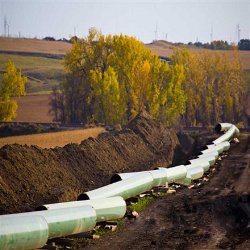TransCanada Corp. (NYSE: TRP) is making a big splash for its plan for a pipeline that would ship oil from Western Canada to the East Coast. Canada’s second largest pipeline operator, refusing to sit idle while its other project to the U.S. Golf Coast sits in limbo, has turned its eye in the complete opposite direction.
The $12 billion Energy East Pipeline project was announced Thursday, marking a crucial step forward for Canada to reach untapped export markets to the east.
 This new pipeline, which still needs regulatory approval, would have a maximum capacity of 1.1 million barrels per day and be in service by 2017.
This new pipeline, which still needs regulatory approval, would have a maximum capacity of 1.1 million barrels per day and be in service by 2017.
If the U.S. wants to continue to foolishly pass on its Keystone XL pipeline, then TransCanada is more than happy to seize the opportunity to Eastern Canada, creating jobs, revenue, and Canadian energy security for years to come.
But that doesn’t mean it got the green light already. Of course, environmentalists have to do their job and make a big production out of it. And Quebec Premier Pauline Marois said last week that her province would be waiting on detailed plans from TransCanada.
But in general, the project is being touted as a strength to the nation. TransCanada is prepared to work closely with the Quebec government to ensure the province gets the maximum benefit from the project. The worry lies now with officials in Quebec City and Montreal, who may fear they will lose business from seaborne imports, but that shouldn’t prove as much concern once job growth saturates the city limits.
And politically, it’s garnered far less opposition than projects like the Keystone XL, where climate change and contention between President Obama and Republicans have brought the project to a complete stand still.
Energy East
When the Energy East Pipeline does come online, and it will, supplies will go to East Coast refineries and export terminals. The project will convert 1,864 miles of existing 42-inch pipeline, according to Bloomberg, and add as much as 900 miles of new pipeline.
As the idea grows, so too does its lofty expectations. Its original estimate of 850,000 barrels a day has already been pumped up to 1.1 million, and TransCanada has reached an agreement with Irving Oil Corp. to construct a new deepwater marine terminal in Saint John, New Brunswick for a cool $300 million.
If plans move as expected, deliveries to Quebec would begin sometime in 2017 and to New Brunswick in 2018.
Refiners would then have a steady flow of North American crude, which as of late has been cheaper than imports. And the New Brunswick port would be able to sustain the world’s largest crude carriers, reducing shipping costs en route to Asia.
With new pipelines in place, companies like Western Canada Energy Ltd. would ship to the U.S. eastern seaboard and as far as Asia. And instead of shelling out for high-priced imports from the Middle East, Canadian refiners would rely on North American supplies.
And the Bakken would become an integral part of shipments, as well, whether it be from the U.S. or the Canadian part of the field.
Keystone XL
But as you well know, not all North American prospects shine bright. The U.S. sits on the Keystone XL, too scared to make a leap of good faith. The $5.3 billion pipeline that is supposed to run from Alberta, Canada to Nebraska is still pending U.S. government approval.
It would link western Canadian producers to the U.S., and together with the newly proposed Energy East, a network between the two countries would bring elation. If we were living in a movie, the two would ride off into the sunset.
But if the Keystone XL remains on the drawing board, leaving us all shaking our heads, then the Energy East can still pick up a lot of the slack and drive future value.
We’ll know for sure later this year when the President makes his decision on the Keystone XL.
Our analysts have traveled the world over, dedicated to finding the best and most profitable investments in the global energy markets. All you have to do to join our Energy and Capital investment community is sign up for the daily newsletter below.
Investing
It would be a blessing to have both the Keystone XL and Energy East come online, especially as oil-sands production is skyrocketing – doubling to 5.2 million barrels per day by 2030, according to Bloomberg. But the two projects are completely independent from one another.
Canadian oil has traded below the U.S. benchmark West Texas Intermediate, but that is solely based on a lack of transportation and infrastructure.
Canadian companies like Enbridge (NYSE: ENB) have made healthy contributions to the Bakken’s infrastructure; they’re sure to do the same once the Energy East gets underway. And countless others are going to want to be a part of this.
It’s not supposed to create much of an environmental footprint at all. A lot of the pipe is pre-existing, and where new development is needed, there are already foundations to follow. TransCanada will use electric pumps to reduce air emissions and gas-compression stations, which are already there, for when it builds new pump stations. The company is doing everything in the most environmentally-friendly way possible.
We really don’t know what will happen with the Keystone XL, but once the Energy East starts laying pipe, the game is going to change.
No ifs, ands, or buts about it.
If you liked this article, you may also enjoy:




